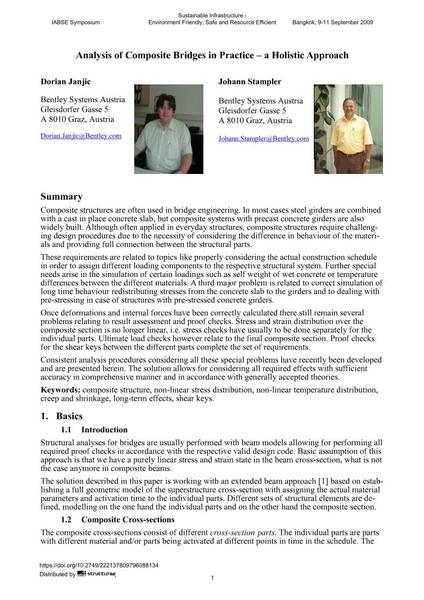Analysis of Composite Bridges in Practice – a Holistic Approach

|
|
|||||||||||
Bibliographic Details
| Author(s): |
Dorian Janjic
Johann Stampler |
||||
|---|---|---|---|---|---|
| Medium: | conference paper | ||||
| Language(s): | English | ||||
| Conference: | IABSE Symposium: Sustainable Infrastructure - Environment Friendly, Safe and Resource Efficient, Bangkok, Thailand, 9-11 September 2009 | ||||
| Published in: | IABSE Symposium Bangkok 2009 | ||||
|
|||||
| Page(s): | 117-126 | ||||
| Total no. of pages: | 8 | ||||
| Year: | 2009 | ||||
| DOI: | 10.2749/222137809796088134 | ||||
| Abstract: |
Composite structures are often used in bridge engineering. In most cases steel girders are combined with a cast in place concrete slab, but composite systems with precast concrete girders are also widely built. Although often applied in everyday structures, composite structures require challeng- ing design procedures due to the necessity of considering the difference in behaviour of the materi- als and providing full connection between the structural parts. These requirements are related to topics like properly considering the actual construction schedule in order to assign different loading components to the respective structural system. Further special needs arise in the simulation of certain loadings such as self weight of wet concrete or temperature differences between the different materials. A third major problem is related to correct simulation of long time behaviour redistributing stresses from the concrete slab to the girders and to dealing with pre-stressing in case of structures with pre-stressed concrete girders. Once deformations and internal forces have been correctly calculated there still remain several problems relating to result assessment and proof checks. Stress and strain distribution over the composite section is no longer linear, i.e. stress checks have usually to be done separately for the individual parts. Ultimate load checks however relate to the final composite section. Proof checks for the shear keys between the different parts complete the set of requirements. Consistent analysis procedures considering all these special problems have recently been developed and are presented herein. The solution allows for considering all required effects with sufficient accuracy in comprehensive manner and in accordance with generally accepted theories. |
||||
| Keywords: |
composite structure shear keys creep and shrinkage long-term effects non-linear stress distribution non-linear temperature distribution
|
||||
